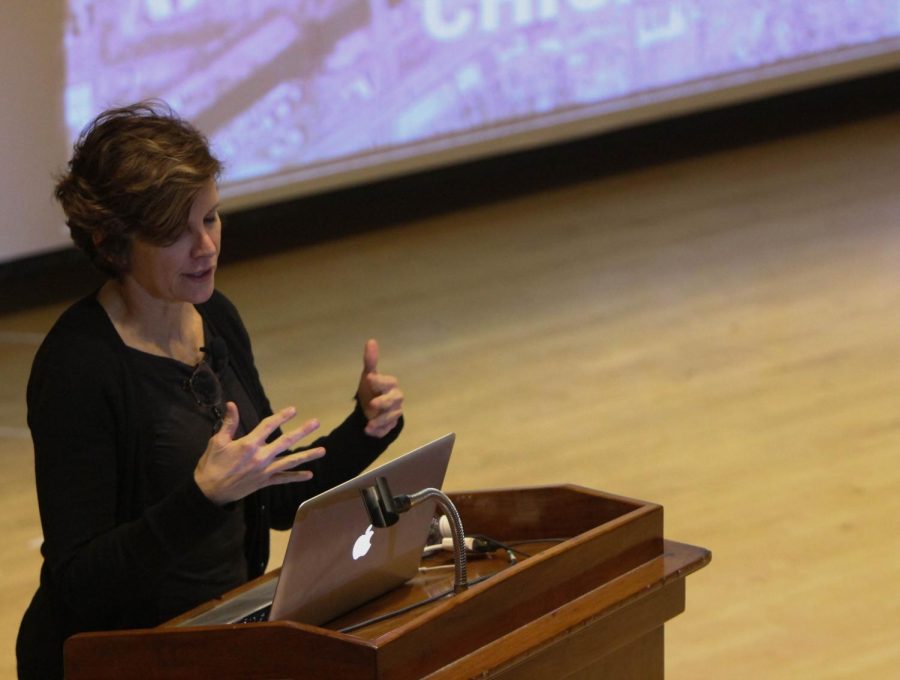Jeanne Gang’s focus on community shapes her architecture
Architect and MacArthur Fellow Jeanne Gang lectures in Cartwright Hall on Jan. 28, 2016 as part of The Thomas Schroth Visiting Artist Series.
January 29, 2016
Chicago based architecture Jeanne Gang presented to students and faculty Thursday night in Cartwright Hall to talk about her community oriented accomplishments.
Gang, a MacArthur Fellow and recipient of the Cooper-Hewitt National Design Award, focuses much of her work to not only create innovate architecture, but architecture that will benefit the surrounding communities, according to the Thomas Schroth visiting artist series.
One of her more famous buildings, known as Aqua Tower, is meant to serve not just businesses and housing, but the community in Chicago as well, Gang explained as she began her lecture.
Gang talked about the unique design of the tower saying how many of the balconies jut out, giving it a different form as it’s gazed from the street below. The purpose for the different style of balconies was to make those that live in Aqua Towers have a sense of community and converse with one another as they stood outside, Gang said.
Along with the Aqua Tower, Gang said she helped clean up Chicago’s river fronts and waterways because they were closed to the public and on top of that was heavily polluted and unattractive, leaving the public with no intentions of even visiting the river fronts.
“One of the things, the process of design was to engage the people that are actually using the space and we approached this more like industrial designers,” Gang said. “We did this by getting community participation and to find out really how everyday people use the river.”
The project produced a cleaner riverfront and an area for the public to go out and enjoy.
Because of the success of the boardwalk, Gang and her team were asked to create boathouses along the riverfront to provide recreational activities for the public. The building would give an area for row teams to practice and take advantage of the now clean rivers.
The building itself is meant to mimic the way that an oar strikes the water when rowing, she added. This gives the building a unique and urban style that would not typically be seen in traditional architecture.
Gang said she is avid about using alternative materials for architecture and figure out their structural capabilities.
The Arcus Center for Social Justice Leadership at Kalamazoo College exemplifies the usage of alternative materials. They used a cordwood style that makes the building have a cork-like material to it. The building’s shape is also unique, Gang said as she explained the design.
“(We) wanted to have the building reach out to the community because the school wanted the building to represent them as ‘out and proud,”’ Gang said.
Gang said all of the architecture is meant to benefit the communities and how the communities interact with the buildings.
Andrew Mozil, a sophomore architecture major, felt that Gang’s outreach with the community was a good idea.
“The community can get involved more and get involved with the area,” Mozil said. “It can help out a lot of communities this way.”
Her biggest project is facing the challenge of getting Chicago’s community to interact with the police enforcement and to build a better relationship between the two.
Currently working on the project known as “Polis Station,” Gang wants to help make the stations more than just police stations but more of a community orientated station. Gang feels that there are plenty of opportunities with this project.
Her team was even able to get the community involved to voice their ideas as well.
“One guy said he felt that one really nice program to combine with the police station is (to make a better relationship) to make a barbershop,” Gang said. “That’s where everybody talks and where everybody gets to know each other and both police need it and community members need it.”
With Gang’s main focus on community within architecture, she is able to create and build things that no one could ever imagine and benefit everyone involved.
“We can design things, we can make things and we can also make things happen.”
Adrian Leuthauser is the College of Architecture and Environmental Design reporter for The Kent Stater, contact him at [email protected]

























